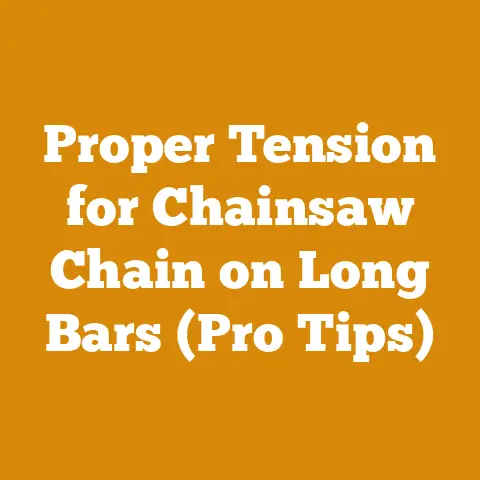Are Sweet Gum Tree Roots Deep? (5 Key Wood Processing Facts)
Are Sweet Gum Tree Roots Deep? (5 Key Wood Processing Facts & Cost Considerations)
Let’s dive into the fascinating world of Sweet Gum trees (Liquidambar styraciflua), their root systems, and, crucially, how understanding their characteristics impacts your wood processing and firewood preparation projects. As someone who’s spent years felling, milling, and splitting wood, I’ve learned that knowing your timber is half the battle – and that includes what’s going on beneath the surface!
The question of whether Sweet Gum roots are deep is more complex than a simple yes or no. It’s a factor that affects not only how difficult the tree is to remove but also the potential damage it can cause and, ultimately, the cost of dealing with it. We’ll explore the root system characteristics and then delve into the crucial wood processing facts that you need to know, including a detailed breakdown of the costs involved in harvesting and processing this unique timber.
1. Understanding Sweet Gum Root Systems: Not Always Deep, But Always Extensive
The truth is, Sweet Gum trees don’t typically have a single, deep taproot like some other species. Instead, they develop a relatively shallow but incredibly widespread and aggressive root system. This is the first key fact to keep in mind.
- Lateral Spread: Sweet Gum roots are notorious for their lateral spread, often extending two to three times the width of the tree’s canopy. That means a tree with a 30-foot crown could have roots reaching 60 to 90 feet outwards! This extensive network makes them adept at absorbing water and nutrients, but it also makes them a headache for homeowners and wood processors alike.
- Surface Roots: A significant portion of the root system remains close to the surface. These surface roots can lift sidewalks, damage foundations, and make mowing a lawn a bumpy experience.
- Aggressiveness: Sweet Gum roots are highly invasive. They will seek out water sources and can even penetrate sewer lines. This is crucial to consider if you’re planning to harvest Sweet Gum near any underground utilities.
- Soil Type Impact: The depth and spread of the root system are influenced by soil type. In well-drained, loamy soils, the roots may penetrate slightly deeper. However, in compacted clay soils, the roots tend to stay closer to the surface and spread even wider.
- Sprouts and Suckers: Sweet Gum trees are prolific sprouters. Damage to the roots can trigger the growth of numerous suckers, creating a thicket of new shoots around the base of the tree. This is a major consideration when removing a Sweet Gum tree, as you’ll need to address the root system to prevent regrowth.
2. Sweet Gum Wood Processing: Key Characteristics and Challenges
Sweet Gum is a hardwood, but it’s not as dense as oak or hickory. This influences its use and the equipment required to process it.
- Grain and Appearance: Sweet Gum has a relatively straight grain and a moderately fine texture. The heartwood is reddish-brown, while the sapwood is a lighter color. It can be stained and finished to resemble more expensive hardwoods like cherry or walnut, making it a popular choice for furniture and trim.
- Workability: Sweet Gum is generally easy to work with hand and power tools. It cuts cleanly, sands smoothly, and accepts nails and screws well. However, it can be prone to warping and twisting if not properly dried.
- Drying: This is where Sweet Gum presents a significant challenge. It has a high moisture content and is prone to warping, twisting, and checking during drying. Proper kiln drying is essential to produce stable lumber. Air drying is possible but requires careful stacking and monitoring.
- Strength and Durability: Sweet Gum is not as strong or durable as some other hardwoods. It’s suitable for interior applications but is not recommended for outdoor use unless treated.
- Uses: Sweet Gum is commonly used for furniture, cabinets, trim, flooring, veneer, and pulpwood. It’s also a decent firewood, though it’s not as high in BTU content as denser hardwoods like oak or maple.
- Firewood BTU Rating: Sweet gum has a BTU rating of approximately 17.7 million BTUs per cord. For comparison, oak can range from 20-24 million BTUs per cord.
3. Cost Breakdown: Harvesting and Processing Sweet Gum
Now, let’s get down to the nitty-gritty: the costs involved in harvesting and processing Sweet Gum. These costs can vary significantly depending on your location, the size and accessibility of the tree, and the equipment you have available. I’ll break down the costs into several categories and provide realistic estimates based on my experience and industry data.
A. Timber Purchase or Harvesting Costs:
- Standing Timber Purchase: If you’re purchasing standing timber (trees that are still growing), the price will vary depending on the volume and quality of the trees. Sweet Gum typically sells for less than premium hardwoods like oak or walnut. Expect to pay anywhere from $100 to $300 per thousand board feet (MBF) for Sweet Gum, depending on the market. To put that in perspective, high-grade oak can fetch $800-$1500/MBF.
- Source: Timber Mart-South report (regional variations apply)
- Logging Costs (if you hire a logger): If you’re hiring a logger to harvest the trees, the cost will depend on the size of the job, the terrain, and the distance to the mill. Logging costs can range from $150 to $400 per MBF. This includes felling the trees, limbing, bucking (cutting into logs), and skidding (dragging the logs to a landing).
- Source: Conversations with local logging contractors in North Carolina.
- Permits and Fees: Depending on your location, you may need permits to harvest timber. These permits can range from a few dollars to several hundred dollars, depending on the size of the project and the regulations in your area. Always check with your local forestry department or natural resources agency.
- Example: In some states, a timber harvesting notification is required for any harvest exceeding a certain acreage.
- DIY Harvesting Costs: If you’re harvesting the trees yourself, you’ll need to factor in the cost of your own labor, as well as the cost of equipment rental or purchase. This includes:
- Chainsaw: A good quality chainsaw can cost anywhere from $300 to $1000. I personally recommend a Stihl or Husqvarna for reliability and performance.
- Safety Gear: This includes a helmet, chaps, gloves, and eye protection. Expect to spend $100 to $300 on safety gear.
- Fuel and Oil: Chainsaw fuel and bar oil can add up quickly, especially if you’re doing a lot of cutting. Budget $20 to $50 per day for fuel and oil.
- Skidding Equipment: If you’re harvesting large trees, you may need a tractor or skidder to move the logs. Renting a tractor can cost $100 to $300 per day.
- Transportation: You’ll need a way to transport the logs to the mill or your property. This may involve renting a truck or trailer. Truck rental can cost $50 to $200 per day.
B. Milling Costs:
- Sawmill Charges: If you’re hiring a sawmill to mill your logs into lumber, the cost will depend on the size of the logs, the type of lumber you want, and the sawmill’s rates. Sawmills typically charge $0.20 to $0.50 per board foot for milling.
- Source: Average sawmill rates across the Southeastern US.
- Portable Sawmill Rental: If you want to mill the lumber yourself, you can rent a portable sawmill. Rental rates can range from $200 to $500 per day.
- DIY Milling Costs: If you own your own sawmill, you’ll need to factor in the cost of maintenance, blades, and fuel. Sawmill blades can cost $20 to $50 each, and you’ll likely need to replace them frequently. Fuel costs will depend on the type of sawmill you have.
C. Drying Costs:
- Kiln Drying: Kiln drying is the most effective way to dry Sweet Gum lumber. Kiln drying costs can range from $0.30 to $0.60 per board foot. This includes the cost of renting the kiln space and the energy required to run the kiln.
- Source: Commercial kiln drying rates in the Appalachian region.
- Air Drying: Air drying is a slower and less expensive option, but it requires more space and time. You’ll need to sticker the lumber properly and allow it to dry for several months or even years. The cost of air drying is primarily the cost of the space and the labor involved in stacking and stickering the lumber.
- Rule of thumb: Air drying takes approximately 1 year per inch of thickness in the Eastern US climate.
D. Firewood Preparation Costs:
- Splitting: If you’re preparing Sweet Gum for firewood, you’ll need to split the logs. You can do this by hand with a splitting maul or with a hydraulic log splitter.
- Manual Splitting: A good splitting maul will cost $50 to $100. The cost of manual splitting is primarily the cost of your labor.
- Hydraulic Log Splitter: Renting a hydraulic log splitter can cost $50 to $100 per day. Owning a log splitter can cost $1000 to $3000.
- Stacking and Seasoning: Once the wood is split, you’ll need to stack it and allow it to season for at least six months, preferably a year. The cost of stacking and seasoning is primarily the cost of the space and the labor involved.
- Transportation: You’ll need a way to transport the firewood to your home or to your customers. This may involve renting a truck or trailer.
Example Cost Scenario: Harvesting and Milling Sweet Gum for Furniture
Let’s say you want to harvest and mill enough Sweet Gum to build a dining room table. You estimate that you’ll need 200 board feet of lumber.
- Standing Timber: At $200 per MBF, 200 board feet will cost you $40.
- DIY Harvesting:
- Chainsaw fuel and oil: $30
- Chainsaw maintenance: $10
- Your labor (2 days at $100/day): $200
- Sawmill Charges: At $0.30 per board foot, milling 200 board feet will cost you $60.
- Kiln Drying: At $0.40 per board foot, kiln drying 200 board feet will cost you $80.
Total Cost: $40 + $30 + $10 + $200 + $60 + $80 = $420
This works out to $2.10 per board foot. This is a relatively low cost, especially when compared to the cost of purchasing kiln-dried Sweet Gum lumber from a lumberyard, which can easily cost $5 to $10 per board foot.
Important Considerations:
- Waste: Always factor in waste when estimating your lumber needs. You’ll likely lose some wood during the milling and drying process. I generally add 10-20% to my lumber estimates to account for waste.
- Unexpected Costs: Be prepared for unexpected costs, such as equipment repairs or unforeseen problems with the timber. It’s always a good idea to have a contingency fund.
- Time: Don’t underestimate the amount of time involved in harvesting and processing timber. It can be a time-consuming process, especially if you’re doing it yourself.
4. Optimizing Costs and Budget Management
Here are some practical tips for optimizing costs and managing your budget when working with Sweet Gum:
- Source Your Timber Wisely: Look for opportunities to purchase standing timber at a discounted price. Contact local landowners or forestry companies to see if they have any Sweet Gum trees they want to get rid of.
- Do it Yourself (Where Possible): If you have the skills and equipment, consider doing some of the work yourself. Felling trees, limbing, bucking, and splitting firewood can all be done with basic tools and some elbow grease.
- Rent Equipment: Renting equipment can be a cost-effective alternative to purchasing it, especially if you only need it for a short period of time.
- Air Dry Your Lumber: Air drying is a cheaper alternative to kiln drying, but it requires more time and space. If you have the patience, air drying can save you a significant amount of money.
- Negotiate with Sawmills: Don’t be afraid to negotiate with sawmills on their rates. If you have a large volume of timber, you may be able to get a better price.
- Minimize Waste: Take care to minimize waste during the milling and drying process. Use sharp blades, sticker the lumber properly, and monitor the drying process closely.
- Season Firewood Properly: Seasoning firewood properly will increase its BTU content and make it easier to burn. This will save you money on heating costs in the long run. Aim for at least six months, but a year is ideal.
- Consider the Environmental Impact: Sustainable forestry practices can help to ensure that timber resources are available for future generations. Choose to harvest timber responsibly and replant trees whenever possible.
- Utilize Free Resources: There are many free resources available online and through local forestry agencies. Take advantage of these resources to learn more about timber harvesting, wood processing, and firewood preparation.
Case Study: Small-Scale Firewood Business with Sweet Gum
I know a small-scale firewood supplier in my area who focuses on Sweet Gum. He’s built a successful business by understanding the market, optimizing his costs, and providing excellent customer service.
- Sourcing: He sources his Sweet Gum from local landowners who are clearing land for development. He often gets the timber for free or at a very low cost.
- Processing: He uses a combination of manual and hydraulic splitting to process the firewood. He has a small team of workers who help him with the splitting and stacking.
- Seasoning: He has a large, well-ventilated storage area where he seasons the firewood for at least a year.
- Marketing: He markets his firewood online and through local classified ads. He emphasizes the affordability of Sweet Gum compared to other hardwoods.
- Profitability: He’s able to sell his Sweet Gum firewood for a reasonable price and still make a good profit. His success is due to his ability to source timber cheaply, process it efficiently, and market it effectively.
5. Addressing the Root of the Problem: Sweet Gum Root Management
Now, let’s circle back to the original question about Sweet Gum roots. If you’re removing a Sweet Gum tree, you need to address the root system to prevent regrowth and minimize damage.
- Complete Removal: The most effective way to prevent regrowth is to remove the entire root system. This can be done with heavy equipment, such as an excavator or backhoe. However, this can be expensive and disruptive.
- Grinding: Another option is to grind the stump and the surrounding roots with a stump grinder. This is less disruptive than complete removal, but it may not prevent regrowth entirely.
- Chemical Treatment: Chemical treatment can be used to kill the root system. However, this can be harmful to the environment and may not be effective in all cases. Always follow the manufacturer’s instructions carefully.
- Physical Barriers: Installing physical barriers, such as root barriers, can help to prevent the roots from spreading and damaging nearby structures.
- Regular Pruning: Regularly pruning the roots can help to control their growth. However, this can be a time-consuming process.
- Cost of Root Removal: The cost of root removal will depend on the size of the tree, the extent of the root system, and the method used. Expect to pay anywhere from $100 to $1000 or more for professional root removal.
Addressing Root Sprouts:
Even after removing the main tree, Sweet Gum roots often send up new sprouts. Here’s how to deal with them:
- Consistent Cutting: The most environmentally friendly method is to consistently cut the sprouts back to the ground. Eventually, this will exhaust the root system’s energy reserves.
- Herbicide Application: For larger infestations, a systemic herbicide can be applied directly to the freshly cut sprouts. This will kill the roots and prevent regrowth. Be extremely careful when using herbicides and follow all label instructions. Glyphosate and Triclopyr are common active ingredients used for this purpose.
- Mulching: A thick layer of mulch can help to suppress sprout growth.
Sweet Gum: A Rewarding, But Challenging, Wood
Sweet Gum is a versatile and attractive wood that can be used for a variety of purposes. However, it’s important to be aware of its challenges, including its aggressive root system and its tendency to warp and twist during drying. By understanding these challenges and taking appropriate precautions, you can successfully harvest, process, and utilize Sweet Gum for your woodworking and firewood projects.
The key is to approach Sweet Gum with a plan. From the initial harvest to the final finish, each step requires careful consideration and attention to detail. But the rewards – beautiful lumber, affordable firewood, and the satisfaction of working with your own hands – are well worth the effort.






